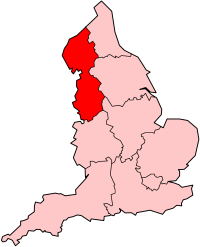|
Carlisle power stations
Carlisle power stations were two electricity generating stations that supplied electricity to Carlisle and the surrounding area from 1899 until 1980. The first power station (1899–1927) was in the centre of the city near Nelson Bridge, and the second larger station was at Willow Holme North-West of the city (1923–1980). BackgroundCarlisle Corporation sought, and obtained, from the Board of Trade a Provisional Order to generate and supply electricity to the City of Carlisle in 1895. The Order was confirmed by Parliament in the Electric Lighting Orders Confirmation (No.3) Act 1895 (58 & 59 Vict. c. lxviii).[1] An electric lighting scheme for the city was designed by Sir Alexander Kennedy and construction of the power station started in 1897.[2] James Street stationThe power station was built by J. W. Laing[3] in James Street at the junction with Nelson Bridge or Victoria Viaduct (54°53'24.7"N 2°56'09.6"W).[4] The station shared coaling facilities with the adjacent gas works immediately to the North.[5] Water for the power station's condensers was abstracted from, and returned to, the adjacent River Caldew. The station had a single brick chimney and first produced electricity in 1899. In about 1910 the building was extended to the rear.[3] SpecificationIn 1923, towards the end of its working life, the plant installed at the James Street power station comprised coal-fired boilers producing 87,500 lb/hr (11.02 kg/s) of steam which fed the following generating plant:[6]
The total installed generating capacity was 5.25 MW. OperationElectricity was supplied to customers at 230 & 400 Volt 3-phase 50 Hz AC; 230 & 460 Volt DC; and 520/540 Volt DC for traction current.[6] Electricity was initially used for lighting, replacing gas lamps, but other uses were soon developed. The City of Carlisle Electric Tramways Co Ltd, commissioned the tram system in 1900 taking power from the James Street power station. The tram system operated across the city until it closed in 1931.[7] In 1923 the power station sold 7,133.9 MWh of electricity. This was distributed to the following users:[6]
The maximum electrical load on the system in 1923 was 3,983 kW and there was a connected load of 11,552 kW.[6] The revenue from the sale of current amounted to £55,039. The surplus of revenue over expenses for the Corporation was £23,987.[6] Closure and aftermathThe constrained James Street site was too small for new larger generating plant to meet the increasing demand for electricity following the First World War. In the decade following the War the national consumption of electricity more than doubled from 3577.7 GWh in 1919 to 8746 GWh in 1929.[8] A new power station was built at Willow Holme. The James Street station was closed in 1927.[3] The electricity equipment was removed soon after and the chimney demolished.[3] The building was used as stores, a maintenance depot and offices. An extension was built in 1937 in 'Moderne' style to make more office space and the building was used by the electricity undertaking and later by NORWEB – the Area electricity board – until 1987.[3] The building then became the Carlisle Enterprise Centre. Formal 'listing' of the building as of special architectural or historic interest was rejected in 2015.[3] The grounds for rejection were the building had undergone significant change; the generating equipment had been removed; and there was a lack of architectural interest in the functional eclectic nature of the buildings.[3] Willow Holme stationTo cater for the increase in demand for electricity following the First World War a large modern power station was built at Willow Holme, or Willowholme (54°54'01.1"N 2°57'31.7"W)[9] on the River Eden West of the municipal sewage works. The site was developed in two phases, low pressure (LP) steam units were installed in 1923–30[10] and high pressure plant (HP) in 1943–44.[11] SpecificationThe plant at Willow Holme comprised:[11]
The total evaporative capacity of the boilers was 875,000 lb/h (110.2 kg/s).[11] Cooling water for the condensers was abstracted from, and returned to, the River Eden. The generating plant comprised:[11]
The station had an installed capacity of 86.9 MW and an output capacity of 69 MW.[11] Government electricity policyUnder the terms of the Electricity (Supply) Act 1926 the Central Electricity Board (CEB) was established.[12] The CEB identified high efficiency 'selected' power station that would supply electricity most effectively; Carlisle became a selected station. The CEB also constructed the national grid (1927–33) to connect power stations within a region.[12] Carlisle was a node on the major North–South line from Kilmarnock in Scotland to Carlisle, Lancaster, Stoke-on-Trent, Bristol and Hayle Cornwall.[8] The connection in Carlisle was at a 132 kV grid substation that was built immediately West of Willow Holme power station.[9] The substation also distributed electricity at 33 kV. When the electricity supergrid was being built in the 1960s the Carlisle substation was connected via a 132 kV line to the 400/275 kV substation at Harker, North of Carlisle.[12][13] Upon nationalisation of the British electricity supply industry in 1948 under the provisions of the Electricity Act 1947 the Carlisle undertaking was abolished,[12] ownership of Carlisle power station was vested in the British Electricity Authority, and subsequently the Central Electricity Authority and the Central Electricity Generating Board (CEGB).[12] At the same time the electricity distribution and sales responsibilities of the Carlisle electricity undertaking were transferred to the North Western Electricity Board (NORWEB). OperationsOperating data for Willow Holme power station[14] was as follows:[11][15][16][17][18]
With its low thermal efficiency the low pressure (LP) station was used less often (see table) and was decommissioned in 1959–60. By 1971 only two of the HP generating sets were operational (1 × 30 MW and 1 × 32 MW).[17][16] ClosureBy 1980 several new efficient power stations were coming online and the CEGB decommissioned older and less efficient power stations. Carlisle power station was among five stations closed on 27 October 1980.[19] The power station was demolished in about 1988.[20] The adjacent 132 kV substation is extant and supplies electricity to Carlisle from the National Grid.[13] See alsoReferences
|
|||||||||||||||||||||||||||||||||||||||||||||||||||||||||||||||||||||||||||||||||||||||||||||||||||||||||||||||||||||||||||||||||||||||||||||||||||||||||||||||||||||||
Portal di Ensiklopedia Dunia

